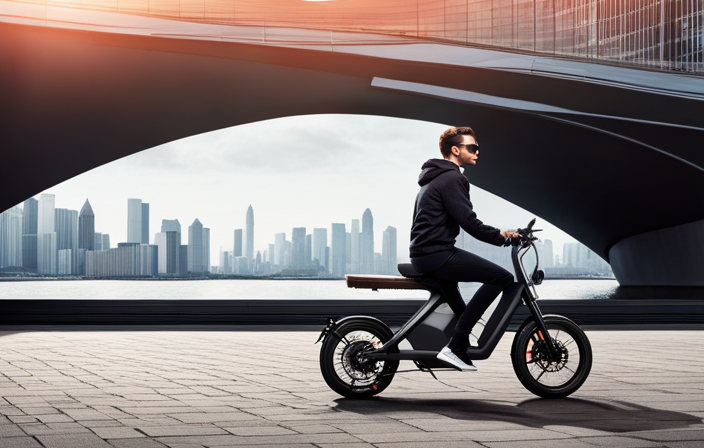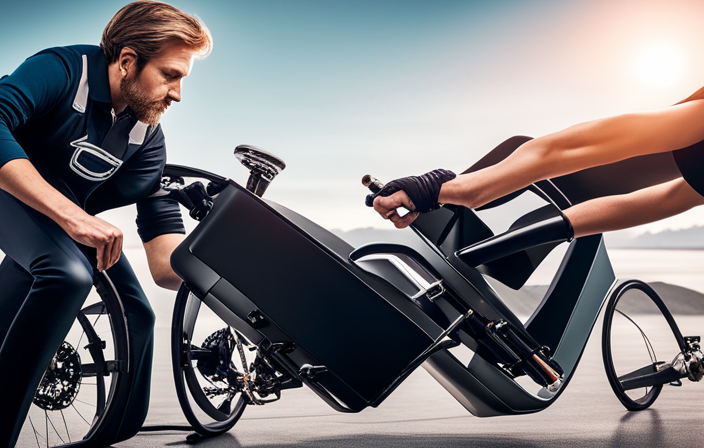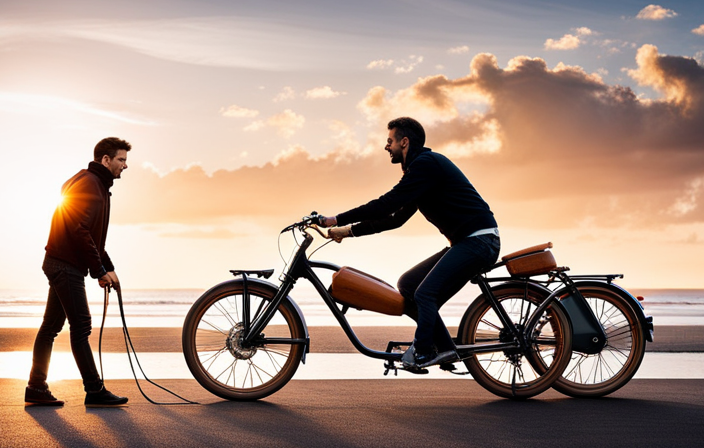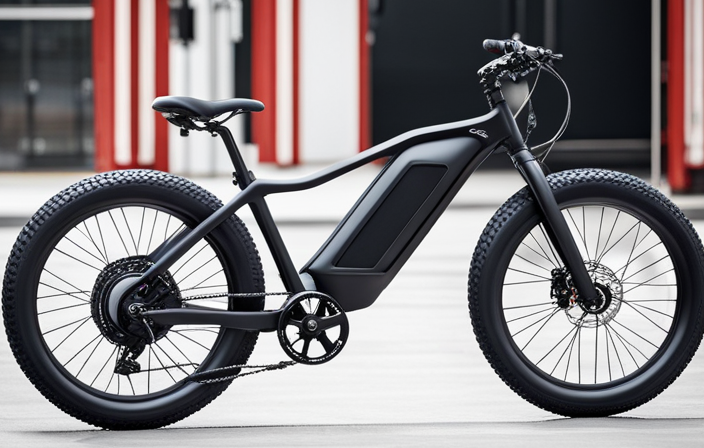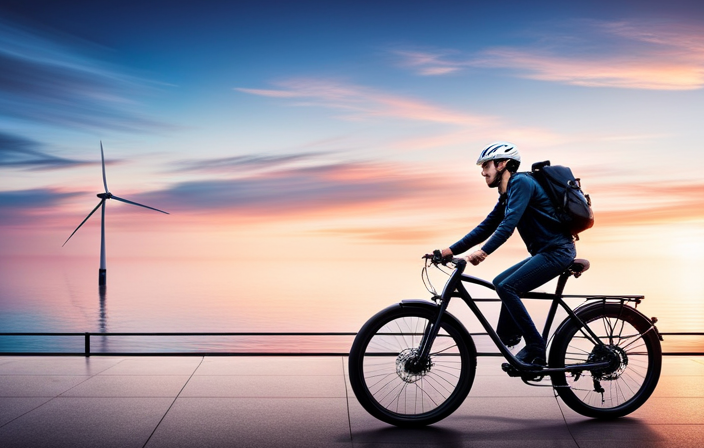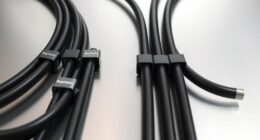Imagine the freedom of effortlessly gliding through the streets, with the wind in your hair and the thrill of speed at your fingertips.
Now, picture transforming your ordinary bicycle into an electrifying machine that can take you on this exhilarating journey.
In this article, I will guide you through the process of converting your bike into an electric marvel. From assessing your bike’s suitability for conversion to choosing the right conversion kit, we will explore all the necessary steps to make your bike electric.
Get ready to embark on a thrilling ride like no other!
Key Takeaways
- Assess the suitability of the bike for conversion by considering factors such as frame size, weight capacity, and compatibility.
- Research and choose a conversion kit that matches the bike’s needs and specifications, considering factors like budget, quality, and reputation of the manufacturer.
- Gather all the necessary tools and equipment, including the conversion kit, wrenches, screwdrivers, pliers, and a voltmeter or multimeter for testing electrical connections.
- Prepare the bike for conversion by removing unnecessary components, addressing any damage or wear, and ensuring the bike is in good working order before proceeding with the conversion.
Benefits of an Electric Bike
There are many benefits of riding an electric bike. Not only does it provide a fun and efficient mode of transportation, but it also has a positive environmental impact. Electric bikes produce zero emissions, helping to reduce air pollution and combat climate change.
Additionally, they are more cost-effective compared to traditional vehicles. With rising fuel prices, an electric bike allows you to save on transportation costs. Charging an electric bike is significantly cheaper than refueling a gas-powered vehicle. Moreover, electric bikes require less maintenance and have fewer parts that can break or wear out, leading to further cost savings.
To assess your bike’s suitability for conversion, you need to consider factors such as the frame size, weight capacity, and compatibility with a motor and battery system.
With these benefits in mind, let’s now move on to assessing your bike’s suitability for conversion.
Assess Your Bike’s Suitability for Conversion
Evaluate if your bicycle is suitable for conversion to an electric model. Before diving into the world of bike conversion, it’s crucial to assess your bike’s suitability. Here are three key factors to consider:
-
Frame: Ensure that your bike’s frame is sturdy enough to support the additional weight of the electric components. A strong and durable frame will provide stability and safety during your rides.
-
Brakes: Check if your bike’s brakes are in good condition. Electric bikes tend to be faster and heavier than traditional bikes, so it’s essential to have reliable brakes that can handle the increased speed and weight.
-
Wheel Size: Take into account your bike’s wheel size. Electric conversion kits are available for various wheel sizes, but it is crucial to choose a kit that matches your existing wheel size for proper fitment and performance.
By carefully assessing these factors, you can determine if your bike is suitable for conversion. Once you’ve evaluated your bike’s suitability, it’s time to research and choose the right conversion kit.
Research and Choose the Right Conversion Kit
To find the perfect conversion kit for you, start by researching and selecting the most suitable option. There are various conversion kit options available in the market that can turn your regular bike into an electric one.
When choosing a conversion kit, there are a few cost considerations to keep in mind. Firstly, consider your budget and determine how much you are willing to spend on the conversion. Secondly, think about the additional costs such as batteries, controllers, and other accessories that may be required.
It is also important to consider the quality and reputation of the manufacturer when selecting a conversion kit.
Once you have gathered all the necessary information, you can move on to the next step of gathering the necessary tools and equipment for the conversion process.
Gather the Necessary Tools and Equipment
Start by gathering all the tools and equipment you’ll need for the bike conversion process. This stage is crucial to ensure a smooth and efficient conversion.
The necessary equipment includes a conversion kit, which typically consists of a motor, battery, controller, and wiring harness. You’ll also need a set of wrenches, screwdrivers, pliers, and wire cutters for the installation process. It’s important to have a voltmeter or multimeter to test the electrical connections and ensure everything is properly wired. Additionally, you may need zip ties, electrical tape, and heat shrink tubing for securing and protecting the wiring.
Once you have all the necessary tools and equipment, you can proceed to the next step of preparing your bike for conversion by removing unnecessary components and assessing its compatibility with the conversion kit.
Prepare Your Bike for Conversion
First, check your bicycle for any unnecessary components that can be removed to make room for the electric conversion kit. Assess the bike’s condition and make sure it is in good working order before proceeding.
Look for any signs of damage or wear, such as rusted parts or worn-out tires, and address them appropriately.
Once you have determined that your bike is suitable for conversion, it’s time to choose a suitable conversion kit. Consider factors such as the power output, battery capacity, and compatibility with your bike’s frame. Research different options and read reviews to find the best kit for your needs.
After preparing your bike for conversion and selecting the right kit, you can now move on to the next step of the process: installing the electric wheel or motor.
Install the Electric Wheel or Motor
Next, you’ll need to install the electric wheel or motor onto your bicycle. To begin, gather the necessary tools: a wrench, screwdriver, and the electric wheel or motor kit.
Start by removing the existing wheel from your bike. Then, carefully align the electric wheel or motor with the frame, ensuring that it fits securely. Use the appropriate screws or bolts to attach the wheel or motor to the frame, tightening them firmly.
Once the electric wheel or motor is securely fastened, double-check all connections to ensure they are tight and secure. This step is crucial to ensure proper functionality and safety.
With the electric wheel or motor now installed, you can proceed to the next section, where we will discuss how to connect the battery and controller.
Connect the Battery and Controller
Now, you’ll want to connect the battery and controller to complete the installation process.
Before proceeding, ensure that the battery is fully charged and the controller is functioning properly.
Start by locating the battery compartment on your bike. Open it up and identify the positive and negative terminals.
Take the corresponding wires from the controller and connect them securely to the battery terminals, making sure to match positive with positive and negative with negative.
Once connected, double-check the tightness of the connections to avoid any potential issues while riding.
It is important to regularly inspect and maintain the battery to ensure optimal performance and longevity. Additionally, familiarize yourself with controller troubleshooting techniques in case any issues arise.
Now, let’s move on to the next step and install the throttle or pedal assist system.
Install the Throttle or Pedal Assist System
To install the throttle or pedal assist system, you’ll need to attach it securely to your bike’s handlebars or frame. There are two main options to consider: throttle and pedal assist.
The throttle system allows you to control the speed of your electric bike by simply twisting the throttle, similar to a motorcycle. On the other hand, the pedal assist system provides assistance as you pedal, giving you a more natural riding experience.
When choosing a conversion kit, it’s important to compare different options available in the market. Look for a kit that suits your needs and budget. Some kits come with both throttle and pedal assist options, giving you the flexibility to switch between them. Others may offer additional features such as LCD displays or multiple power levels.
Take into account the battery range, motor power, and ease of installation when making your decision.
Now that the throttle or pedal assist system is securely attached, we can move on to the next step of testing and adjusting the electric components.
Test and Adjust the Electric Components
You’ll need to test and adjust the electric components to ensure they are functioning properly. Adjusting electric components is an important step in the process of making your bike electric. It ensures that all the electrical systems are working correctly and optimally. Troubleshooting common issues is also crucial during this phase. It allows you to identify and fix any problems before they become major issues. To emphasize the importance of testing and adjusting, consider the following table:
| Electric Component | Testing Method | Adjustment Required |
|---|---|---|
| Battery | Voltage check | Recharge or replace |
| Motor | Bench test | Fine-tuning |
| Controller | Diagnostic tool | Calibration |
| Wiring | Continuity check | Rewiring |
By following these steps, you can ensure that your electric bike functions efficiently and safely. Once the electric components have been properly tested and adjusted, you can move on to the next section to ensure proper wiring and safety measures are in place.
Ensure Proper Wiring and Safety Measures
Once the electric components have been tested and adjusted, it is important to ensure proper wiring and safety measures are in place. This will help prevent any electrical issues and ensure the safety of both the rider and the bike.
One important aspect to consider is wire routing. Make sure all wires are neatly organized and secured to avoid any potential damage or interference with other bike components.
Additionally, it is crucial to wear appropriate safety gear while working with the electrical system, such as gloves and safety glasses, to protect yourself from any potential hazards.
Lastly, always double-check all connections and ensure they are properly insulated to prevent any short circuits or electrical malfunctions. It is crucial to prioritize safety throughout the entire process of making your bike electric, as it will help prevent accidents and ensure a smooth and enjoyable ride.
Moving forward, we will now discuss how to upgrade your bike’s brakes and suspension (optional).
Upgrade Your Bike’s Brakes and Suspension (Optional)
After ensuring proper wiring and safety measures for your electric bike, you may want to consider upgrading your bike’s brakes and suspension for an enhanced riding experience.
Upgrading the brakes will provide better stopping power and control, especially when riding at higher speeds. Additionally, improving the suspension system will result in a smoother and more comfortable ride, especially when encountering bumps and uneven terrain.
When upgrading your bike’s handlebars, consider choosing ones that provide a comfortable grip and ergonomic design, allowing for better control and maneuverability. Furthermore, selecting the right electric conversion kit is crucial for a successful conversion.
Look for a kit that is compatible with your bike’s specifications, has a reliable motor and battery system, and offers good performance. By upgrading these components, you can significantly enhance the overall performance and enjoyment of your electric bike.
Now, let’s move on to the next section and learn how to maintain and care for your electric bike.
Learn How to Maintain and Care for Your Electric Bike
To keep your e-bike in optimal condition, it’s important to learn how to properly maintain and care for it. Here are three key maintenance tips for electric bike owners:
-
Regularly clean and inspect your e-bike: Wipe down the frame, clean the chain, and check for any loose bolts or damage. This will help prevent dirt and grime from affecting the bike’s performance and ensure safe operation.
-
Keep your battery charged and stored properly: Charge your battery after each ride and avoid letting it completely drain. Store it in a cool, dry place to prolong its lifespan and prevent damage.
-
Troubleshoot common electric bike issues: Familiarize yourself with common problems like motor issues or faulty connections. Learn how to diagnose and fix these issues to save time and money.
By following these maintenance practices, you can ensure that your electric bike stays in top shape and performs optimally.
Now, let’s discuss how to follow local laws and regulations for electric bikes.
Follow Local Laws and Regulations for Electric Bikes
Make sure you familiarize yourself with the local laws and regulations regarding the use of e-bikes. It is important to understand the rules in your area to ensure a safe and legal riding experience. Riding an electric bike comes with numerous benefits, such as reducing your carbon footprint and saving money on transportation costs. However, it is crucial to follow the guidelines set by your local government to avoid any potential fines or legal issues.
To help you navigate the regulations, here are some tips for safe riding:
- Always wear a helmet and other protective gear.
- Obey traffic laws, including speed limits and stop signs.
- Ride in designated bike lanes or on the right side of the road.
- Use hand signals to indicate your intentions to other road users.
- Be aware of pedestrians and yield when necessary.
Remember, by following these rules, you can ride your electric bike safely and responsibly, allowing you to enjoy the benefits of your electric bike without any worries.
Enjoy the Benefits of Your Electric Bike
Get ready to experience all the amazing advantages of your e-bike, from cost savings to reduced environmental impact. Here are some ways to maximize the range of your electric bike and choose the right battery:
- Optimize your riding style: Smooth acceleration and maintaining a steady speed can help conserve battery power.
- Choose the right battery capacity: Consider your daily commute distance and the terrain you’ll be riding on to determine the battery capacity that suits your needs.
- Keep your tires properly inflated: This reduces rolling resistance, allowing you to get more mileage out of each charge.
- Maintain your battery: Regularly check the battery’s charge level, clean the contacts, and store it in a cool, dry place to ensure optimal performance.
By maximizing your bike’s range and choosing the right battery, you can enjoy longer rides and make the most of your electric bike.
Now, let’s explore further upgrades and accessories for your electric bike.
Explore Further Upgrades and Accessories for Your Electric Bike
Discover the wide range of upgrades and accessories available to enhance your e-biking experience.
Upgrading your electric bike can not only improve its performance but also customize it to your specific needs.
One popular upgrade is a larger battery, which can extend your riding range and provide more power.
Another option is upgrading the motor to a higher wattage, giving you increased speed and torque.
You can also consider adding a suspension fork or seat post to improve comfort and absorption of bumps.
Accessories such as lights, fenders, and racks are great additions for commuting or touring.
A smartphone holder or GPS can help you navigate easily, while a wireless charger can keep your devices powered up on the go.
Don’t forget to invest in a good lock and helmet for safety.
With these upgrades and accessories, you can truly customize and optimize your electric bike experience.
Frequently Asked Questions
How much does it cost to convert a regular bike into an electric bike?
Converting a regular bike into an electric bike can cost anywhere from $500 to $2000, depending on the quality and features desired. Benefits include increased speed, longer range, and easier hill climbs. Factors to consider are battery capacity, motor power, and weight.
What is the average range of an electric bike on a single charge?
On average, an electric bike can travel up to 40-60 miles on a single charge. Electric bike efficiency is influenced by factors like terrain, rider weight, speed, wind resistance, tire pressure, and battery capacity.
Can I still pedal the bike if the battery runs out?
If the battery runs out, you can still pedal the bike, but there may be limitations. The bike will be heavier and harder to pedal. Some electric bikes also have alternative power sources like solar panels or regenerative braking.
Are there any weight restrictions for riding an electric bike?
Yes, there are weight restrictions for riding an electric bike. It is important to check the specific weight limits set by the manufacturer. Safety tips for riding include proper balance, helmet use, and obeying traffic laws. The benefits of using an electric bike for commuting include reduced carbon emissions and cost savings on fuel.
Can I use the electric bike in the rain or wet conditions?
Yes, you can ride an electric bike in the rain or wet conditions. However, it’s important to use proper riding techniques and perform regular maintenance to ensure safety and prevent damage to the bike’s electrical components.
Conclusion
In conclusion, converting my bike into an electric one has been a game-changer.
Not only have I experienced the joy of effortless rides, but I have also contributed to a greener environment.
Taking the plunge and investing in a conversion kit was definitely worth it.
Now, I can zip through the streets with the wind in my hair and a smile on my face.
So why wait? Grab your tools, ignite your passion, and let your bike soar on the wings of electricity.
It’s time to electrify your ride!
